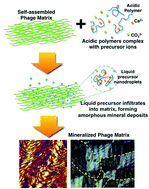Engineered phage films as scaffolds for CaCO3 biomineralization
Abstract
M13 bacteriophages (phage) were exploited as CaCO3 mineralization scaffolds for hard tissue engineering applications. M13 phage was first self-assembled into biomimetic fibrous scaffolds, followed by CaCO3 biomineralization via the polymer-induced liquid precursor process. The phage scaffolds successfully incorporated calcium carbonate, facilitating nucleation and growth of spherulitically textured calcite. The Young's modulus of the scaffolds increased by an order of magnitude after mineralization while also supporting the growth of mouse fibroblasts. These findings demonstrate that phage-based biomaterials are a feasible platform for creating biomineralized hard tissue constructs, in support of future studies in hard tissue engineering and biomedical applications.


 Please wait while we load your content...
Please wait while we load your content...